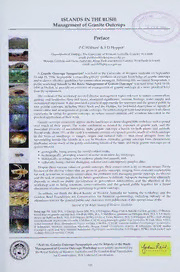
Islands in the Bush: Management of Granite Outcrops PDF
Preview Islands in the Bush: Management of Granite Outcrops
ISLANDS IN THE BUSH: Management of Granite Outcrops Preface P C Withers' & S D Hopper2 •Department of Zoology, The University of Western Australia, Crawley WA 6009 email: [email protected] 2Botanic Gardens and Parks Authority, Kings Park and Botanic Garden, West Perth WA 6005 email: [email protected] A Granite Outcrops Symposium* was held at the University of Western Australia on September 14 and 15, 1996, to promote a cross-disciplinary synthesis of current knowledge of granite outcrops and to derive effective guidelines for conservation managers. Following this successful Symposium, a public workshop Islands in the Bush: Management of Granite Outcrops* was held from April 16-18, 1999 at Hyden, to provide an overview of management of granite outcrops at a more practical level than the symposium. The content of the workshop covered diverse management topics relevant to nature conservation, geology and landforms, flora and fauna, aboriginal significance, tourism, heritage, water supply and recreational enjoyment. It also provided a practical opportunity for scientists and the general public to tour granite outcrops, including Wave Rock and the Humps, for first-hand description of aspects of conservation and management of granite outcrops. Presenters ranged from land managers with direct experience in caring for granite outcrops, to nature conservationists and scientists interested in the practical application of their work. Granite outcrops commonly appear on the landscape as dome-shaped hills with bare rock exposed over much of their aspect. The water catchment so formed by expanses of granite rock, and the associated diversity of microhabitats, make granite outcrops a haven for both plants and animals. World-wide, about 15% of the earth's continents consists of exposed granite, much of which outcrops in the form of inselbergs — ranges, ridges and isolated hills — that stand abruptly from the surrounding terrain like islands in a sea. In Western Australia, granite outcrops form characteristic landforms across much of the gently undulating terrain of the State, and these granite outcrops are of special interest • geologically, being among the world's oldest rocks, • hydrologically, providing a source of water in an often dry landscape, • biologically, as refuges rich in endemic plants and animals, and • culturally, being vital for aboriginal, colonial and contemporary peoples alike. Despite these various values of granite outcrops, their conservation is by no means secure. Partly because of the diverse values that are given to granite outcrops, ranging from economic exploitation for rock, to tourism, to nature conservation, the problems with managing granite outcrops are diverse and the task of conserving them for future generations is difficult. Adequate management ultimately depends as much on public participation as government intervention, and the objective of this workshop was to bring scientists, conservationists and the general public together for a broad discussion of conservation issues pertaining to granite outcrops. As editors, we thank the Royal Society of Western Australia for hosting the workshop, and the Gordon Reid Foundation for Conservation for financial sponsorship, including subsidy of the attendance fees for the general public and assistance with publication of this special issue of the Journal of the Royal Society of Western Australia. From top: Mt Arid, WA, A George; Spear Hill, WA, S D Hopper, Kings Park & Botanic Garden; granites, D Blumer; lizard trap on granite outcrop near Woolbale Hills, WA, T Middleton; gnamma on Pildappa Rock, WA, I A E Bayly; Boryia on Sullivan Rock, WA, S D Hopper, KPBG; Olelia at Twine Reserve, WA, S D Hopper, KPBG; clam shrimp (conchostracan crustacean) Limnadia, J McRae, CALM; mygalomorph spider Teyl lucukntus, B York Main, UWA; water boatman (bug, Hemiptera) Sigara mullaka, J McRae, CALM; western toadlet Pseudophryne occidentalis, R Johnstone, Western Australian Museum; dragon lizard Ctenophorus ornatus, R Johnstone, WAM; mallee Eucalyptus caesia and New Holland honeyeater Phylidonyris novaehollandiae, S D Hopper, KPBG; black-footed rock wallaby Petrogale lateralis, CALM. * Both the Granite Outcrops Symposium and the Islands in the Bush: Management of Granite Outcrops Workshop were jointly sponsored by the Royal Society of Western Australia and the Gordon Reid Foundation for Conservation, WA Lotteries Commission. 101
